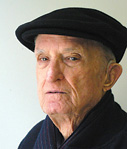William C. Parkinson
William C. Parkinson, professor emeritus of physics, died March 19 at the age of 94.
A native of Ontario, Canada, Parkinson earned his collegiate degrees at U-M, his Bachelor of Science in 1940, Master of Science in 1941, and a Ph.D. in 1948 as a student of Physics Professor H.R. Crane. He joined the U-M faculty as instructor of physics in 1947 and retired in 1988.

Photo by Jens C. Zorn.
During World War II, he joined the Navy’s VT Proximity Fuze project at the Applied Physics Laboratory of John Hopkins University. Parkinson’s work at Johns Hopkins with the Office of Science Research and Development (OSRD) earned him a Certificate of Merit from the OSRD and Ordinance Development Award from the Department of the Navy.
After the war, he assumed responsibility for the research program of the U-M 42-inch cyclotron. Built in 1935, it was then the world’s highest energy cyclotron. It was upgraded in 1939 and accelerated deuterons to 15 MeV. Parkinson was a Fulbright Research Scholar at the Cavendish Laboratory at Cambridge University, England in 1952-53.
From 1962-77, funded by the Atomic Energy Commission and the state of Michigan, Parkinson led the design, construction, testing, and operation (for nuclear research) of the U-M 83-inch cyclotron, which accelerated protons to 45 MeV. This was the first cyclotron to utilize strong (sector) focusing, and it was used extensively in the study of nuclear structure phenomena. There, Parkinson continued his own experiments on nucleon transfer reactions, elastic scattering, multi-particle transfers and heavy ion reactions as he continued to refine and improve the new cyclotron and its energy analyzing system.
Parkinson was renowned for his interest in Michigan athletics, particularly his love of swimming. A member of the Flounders, a water polo club, he enjoyed the camaraderie of this group of men for more than 60 years. One of the Flounders put “Parky” to the challenge of designing an automatic swimming timer. Parkinson accepted the challenge and in 1961, his invention of the electronic judging and timing system was trialed. In 1962 the National Collegiate Athletic Association approved its use for all swimming events.
As a professor, Parkinson guided many graduate students in their research; he chaired the doctoral thesis committees of 18 graduate students. In the 1980s, Parkinson turned to his interests in biophysics. He collaborated with U-M Medical School Professor William Beierwaltes, who had originated the utilization of radioactive nuclei for the diagnosis and treatment of cancers. Parkinson produced radioactive iodine-131, which Beierwaltes used to treat thyroid cancers and to locate and diagnose metastatic cancers.
Parkinson was an honorary member of the Graduate “M” Club. His recognitions include fellowship in the American Physical Society and a term as president of Michigan Sigma Xi society. He served on many university and national committees, including the Willow Run Executive Committee, the Bonner Prize Committee, and the Board in Control of Intercollegiate Athletics, and in the Department of Physics, LSA and the Rackham Graduate School.
He was at times a member of the Physics Advisory Panel of the National Science Foundation, a member of the subcommittee on Nuclear Structure of the National Research Council, the sub-panel on Management and Costs of the nuclear program, a consultant on Graduate Science Facilities and served as Chairman of the National Science Foundation fellowship evaluation committee. He was a consultant to the Los Alamos National Laboratory, Oak Ridge National Laboratory, Lawrence Berkeley Laboratory and to the Argonne National Laboratory. Parkinson was a fellow of the American Physical Society, a member of the Biophysical Society and the Bioelectromagnetics Society, and a Quondam Member of Trinity College at Cambridge University, Cambridge, England.
— Submitted by Physics Professor Emeritus Lawrence Jones

